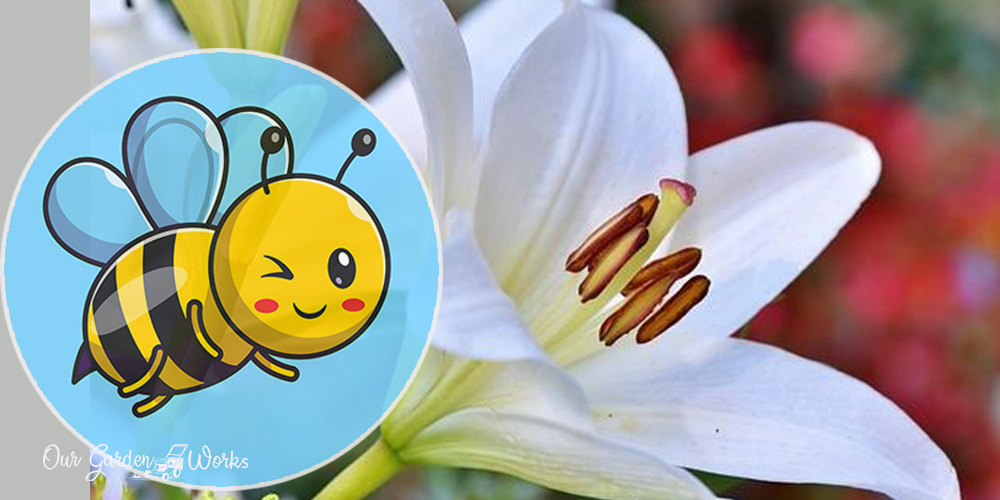The beautiful blooms of lilies, with petals that bends backward, are hard to miss in a garden. More than their enchanting flowers, true lilies are also known to be highly toxic to cats and dogs. So, some gardeners wonder: do bees like lilies or does it repel them?
Bees have two ways to detect flowers: smell and color. According to the University of Würzburg, bees have about 60,000 olfactory receptors in their antennae. These receptors allow them to smell:
- Invading bees that try to enter their hives.
- Chemical signals like pheromones.
- Detecting flowers or toxins.
Unlike the human eye, bees see things differently. They can identify some colors and remain blind to some.
The vision of the human eye is based on three colors: red, blue, and green. Bees, on the other hand, have a vision based on blue, green, and ultraviolet light.
Through their sense of smell and sight, they can choose which flowering plant to feed on and what is dangerous.
Q: Do Bees Like Lilies?
Bees are the primary pollinators of lilies, next to butterflies. Lilies have abundant pollen on their anthers that can even cause powdery stains on your fingers when touched. They can’t detect the color red, so they are more drawn to lilies with white, yellow, blue, pink, and white flowers.
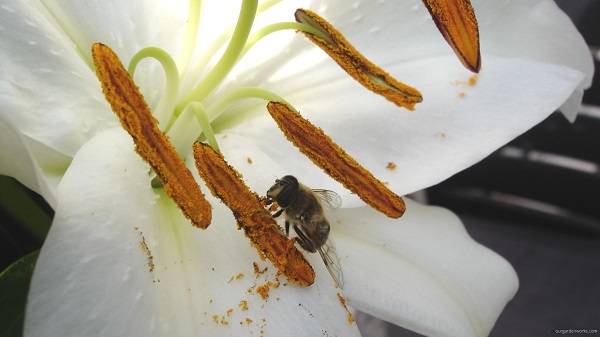
Aside from their color and abundant pollen, lily flowers have an uncomplicated flower structure that makes it easy for pollinators to feed.
The petals are bent backward, revealing the reproductive parts of the flowers that naturally attract pollinators.
The bee species that visit lilies are as follows:
- Honey bees.
- Carpenter bees.
- Bumble bees(eastern).
- Western bees.
Another bee behavior that gardeners notice is their preference for lily varieties that have sturdier stamens and anthers that can support the body weight of both big and small bee species.
Similar flowers that possess these qualities are calla lilies and sunflowers which are known to be bee favorites.
How bees help pollinate lilies
Typical pollination involves the transfer of pollen from a male flower to a female one. However, the pollination in lilies is different since it is considered bisexual. Like roses and tulips, lily flowers have male and female parts in one flower.
Parts of a lily flower
To better understand pollination in lilies, it’s best to learn the parts of a lily flower below:
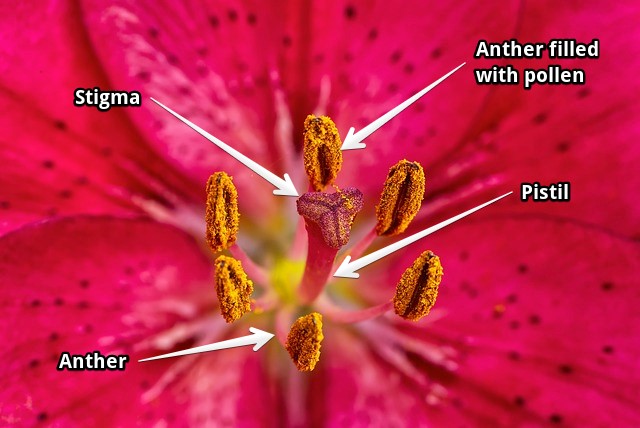
- Pistil: The female part of the lily that is found at the center of each flower. Its base has a small bump, which is the ovary.
- Stamen: A lily flower has six stamens that surround the pistil. It is the male part of the lily where the anthers are connected.
- Anther: The oval-shaped tip of stamens that holds the white, yellow, or orange pollen of lilies.
- Stigma: The sticky tip of the pistil receives the pollen from the anthers and sends the pollen to the ovary where it gets fertilized and turns into seeds.
In a nutshell, pollinating lilies only requires the pollen from the anthers to reach the stigma which is easily done by wandering bees, butterflies, and other pollinators.
Cross-pollinating lilies through pollinators
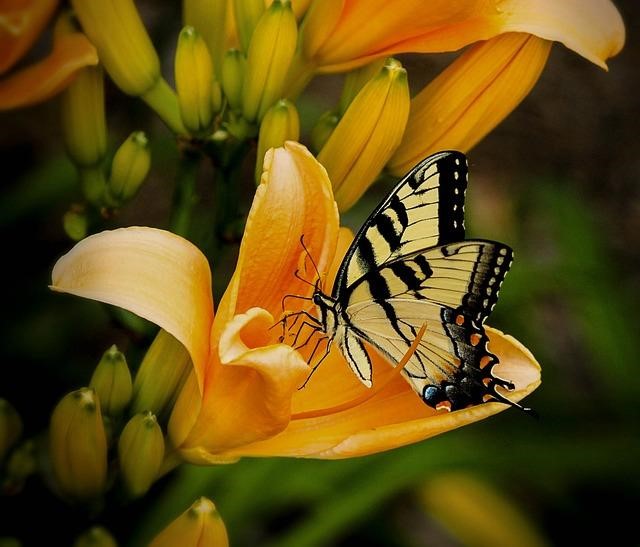
The majority of the lilies that you can find in gardens today are hybrid varieties. They are genetically configured which makes them unable to seed.
For successful cross-pollination between lily species, you must choose the pure breeds of lilies.
Garden lilies are classified into seven hybrid species that may not be suitable for cross-pollination. These include:
- Asiatic hybrids (native East Asian species and hybrids).
- Oriental hybrids (native to Japan).
- Trumpet lilies (trumpet-shaped flowers).
- Martagon hybrids (Turk’s cap curved-shape petals).
- Candidum lilies (native to Europe).
- American hybrids (North American native species)
- Longiflorum hybrids (crosses of selected species used as cut flowers).
Hand-pollinating lilies
In the absence of bees, gardeners often resort to hand pollination to help propagate their plants with seeds.
Ensure that you are crossing pure lilies since hybrid varieties have a lesser chance of developing seeds.
Here’s how you can hand pollinate at home:
- Select a female and male parent from each lily variety you wish to cross. The male parent should be a freshly opened flower since it has more abundant pollen than the old blooms.
- On the female parent, remove the six anthers to prevent the pollen from sticking to the stigma. You can do this using a tweezer.
- Use a cotton swab to transfer the pollen from the male parent to the stigma of the female parent. In some cases, gardeners cut the anthers of the male parent and directly place the pollen on the stigma of the female parent.
- Add a tag on the female parent or separate it from the rest of the plants. Making a distinction for the cross-pollinated lily will allow you to observe its development.
Did You Know? Calla lilies, canna lilies, and daylilies are not true lilies. Though their name contains the word ‘lily’ they come from different plant species. They are usually named as such since they have an uncanny resemblance to the lily flowers in terms of appearance and fragrance.
Lily Varieties That Attract Bees
Pollinators play an important role in the development of fruits and seeds in plants. Hit two birds with one stone by planting the following eye-pleasing lily varieties that will surely invite bees and other pollinators into your garden.
A. Yellow lilies
Bees are highly attracted to yellow lilies. Its bright color allows them to see the flowers from afar and single them out among vegetation.
Aside from inviting bees, yellow blooms can brighten up the atmosphere of your garden. Check out the best yellow lily varieties below:
1. Yellow fawn lilies or Erythronium grandiflorum
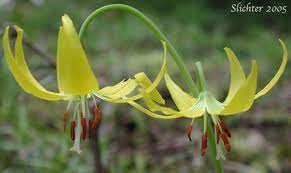
Yellow fawn lily is an herbaceous perennial lily variety. It is also known as glacier fawn lily because it usually emerges as soon as the snow melts.
Often found in southeastern Washington and Idaho, this brightly-colored lily stands out with its white stigma and red, white, or yellow anthers.
As an ideal potted plant, yellow fawn lilies grow from 1 to 3 feet. It usually blooms around May, June, and July. Like other lilies, it is fond of moist soil and thrives in partial shade.
2. Aurelian lilies or Trumpet lilies – Golden Splendor
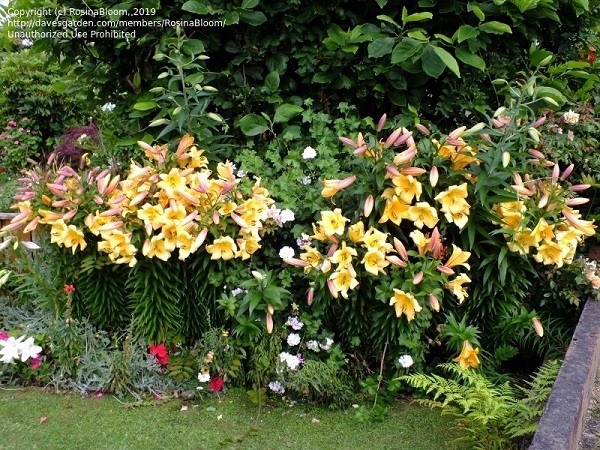
If you are fond of bunches of fragrant blooms, Golden Splendor is a must-have.
It produces a heavy sweet scent that comes from its bunches of flowers. The average bloom per stalk is around 12 to 20 which will surely populate your garden with overflowing yellow flowers.
Golden Splendor is a late bloomer that typically blooms in mid-summer. Though late in the season, it is among those varieties that have a long flowering season which will give enough blooms right before the fall season comes.
B. White lilies
The bright white color of lilies is a spectacle not only to the human eye but also to bees and other pollinators.
If you are more on the minimalist colors and aim for a more peaceful ambiance in your garden, white lilies deserve a spot in your home garden.
Check out the varieties that bees are specifically fond of:
1. White mariposa lily or Calochortus eurycorpus
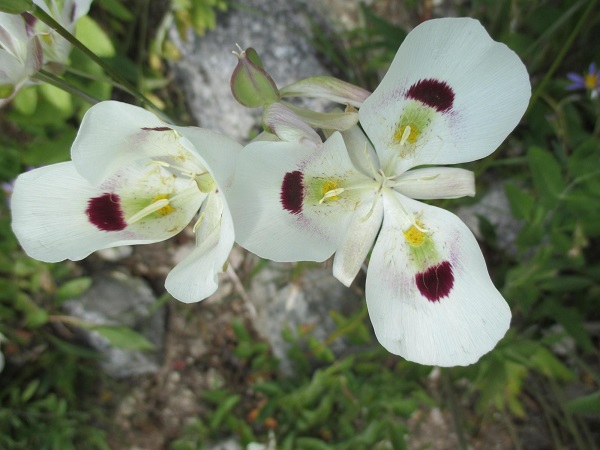
A common sight in the North American wilderness, the white mariposa lily holds a distinct bloom design that easily makes it stand out in the garden.
Its blooms have petals with red or purple blotch from the base spreading towards the mid-section of the petals. Its base also possesses a gland that secretes a sweet substance that attracts beetles and bees.
White mariposa lily grows up to 19 inches (50 cm). It is a perennial plant that blooms around May to July. It produces 1 to 5 blooms that stand out in the wilderness. It is only found in the wild and can be hard to grow in home gardens.
2. White trout lily or Erythronium albidum
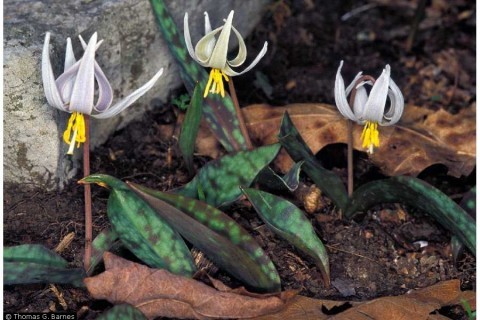
White trout lily, also known as deer’s tongue, is a small geophyte in the lily family that is particularly loved by bumble bees.
It has thick yellow stamens and a stigma that can easily support the weight of big bees like bumble bees.
The petals of a white trout lily are often compared to a snake or deer’s tongue for its 1 to 2 inches length. It is a perennial plant that grows in USDA Hardiness Zones 4 to 8.
Aside from its uniquely shaped petals and bee-favorite stamens, it has a unique growing habit wherein its blooms are facing downward.
C. Pink lilies
Lilies have a broad spectrum of colored blooms that include a pop of pink. The color pink often gives a youthful ambiance to a garden.
If you wish to add some fresh feel to your flower boxes this year, try growing the following pink lilies:
1. Bamboo lily or Lilium Japonicum
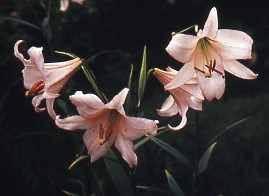
Sasa-yuri is the Japanese term for the pink lily variety known as Lilium japonicum. It is a variety that is often visited by bees and moths for its striking color and abundant pollen. It grows in the colder regions in USDA Hardiness Zones 4 to 8.
Bamboo lilies are a low-growing lily variety that can grow up to 3 feet. They thrive in sandy or loam soil that is moist. It usually starts to bloom in July and loves to bask in partial shade.
2. Asiatic lily – Salmon twinkle lily
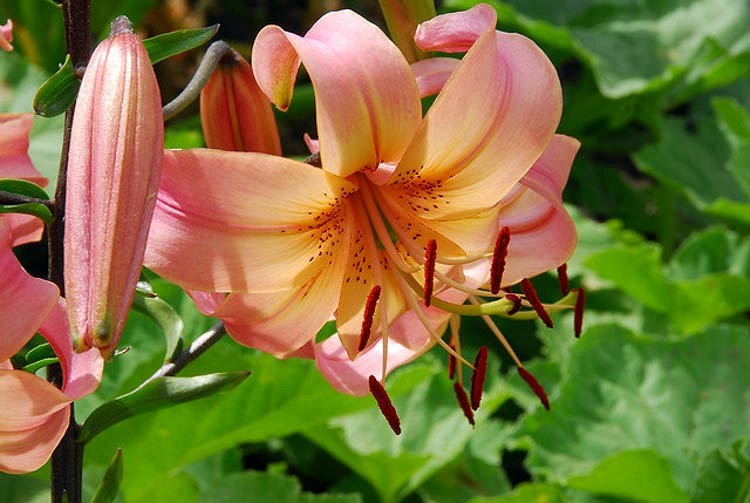
If there’s a lily that seems like it’s cut out from a painting, that would be a salmon twinkle lily.
It is a perennial Asiatic lily that has pinkish violet petals marked with creamy yellow bands from its base. It is an ideal border plant that will fill your garden with beautiful and fragrant blooms in the middle of summer.
Salmon twinkle lily is well-loved by bees and butterflies. Its inviting colors allow the pollinators to spread their pollen and partake in pollination and seed development. It grows up to 3 to 4 feet with the help of moist soil and partial shade.
How to grow lilies at home
Lilies are the very definition of the phrase – looks can be deceiving. They may look complicated to grow but they are among the easiest ones to cultivate. They are not fuzzy about the type of soil and are versatile in sun exposure (depending on the variety).
Here is a list of essential considerations when growing lilies at home:
- Soil requirements: Moist and well-draining soil.
- Season: Spring, summer, or fall.
- Ideal location: USDA Hardiness Zones 4 to 9.
- Fertilization: Apply high-potassium liquid fertilizer twice a month from planting to flowering. It’s best to add compost every spring for better results.
Note: When buying lily bulbs, you must ensure that you will plant them as soon as you go home. Lilies don’t go dormant like other types of bulbs and can rot when left in storage for a long time.
Final Thoughts
Lilies have an irresistible charm that attracts both humans and bees. We hope that this post encourages you to add lilies to your flowering plants this year and allow them to become a pollinator magnet for your local ecosystem.
What is your favorite lily? Let us know in the comments! We might learn new varieties that can be interestingly grown in our respective home gardens!
If you find this post helpful or informative, please don’t forget to share it with your friends and family so you can both geek out about lilies and how they will invite more bees into your area.
